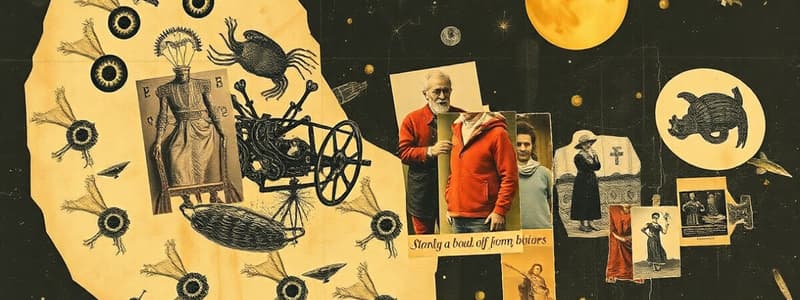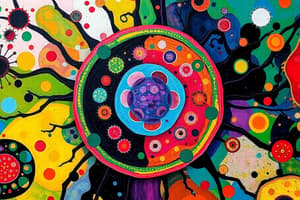Podcast
Questions and Answers
Match the following scientists with their contributions to disproving spontaneous generation:
Match the following scientists with their contributions to disproving spontaneous generation:
Redi = Proved maggots do not arise from rotting meat Pasteur = Showed that microbes are trapped in a gooseneck flask Hooke = Used a microscope to observe cork cells Needham = Suggested that boiling broth could result in spontaneous generation
Match the following cell types with their characteristics:
Match the following cell types with their characteristics:
Prokaryotic cells = DNA floats around in the cell Eukaryotic cells = Have membrane-bound organelles
Match the bacterial reproduction methods with their definitions:
Match the bacterial reproduction methods with their definitions:
Cell Division = One cell duplicates its DNA and splits into two Conjugation = Transfer of plasmid between two connected bacteria Exponential Growth = Population growth where one cell reproduces rapidly Colder Environment = Condition to prevent rapid bacterial reproduction
Match the diseases with their causative agents:
Match the diseases with their causative agents:
Match the following definitions to the correct terms related to diseases:
Match the following definitions to the correct terms related to diseases:
Match the following terms with their meanings regarding zoonotic diseases:
Match the following terms with their meanings regarding zoonotic diseases:
Match the components of the immune system's first line of defense:
Match the components of the immune system's first line of defense:
Match the following concepts to their descriptions in the One Health Theory:
Match the following concepts to their descriptions in the One Health Theory:
Match the terms related to viruses with their descriptions:
Match the terms related to viruses with their descriptions:
Match the following historical concepts of cell theory:
Match the following historical concepts of cell theory:
Match the shapes of bacteria with their names:
Match the shapes of bacteria with their names:
Match the following types of pathogens with their characteristics:
Match the following types of pathogens with their characteristics:
Match the characteristics of bacterial organization:
Match the characteristics of bacterial organization:
Match the bacterial characteristics with their correct descriptions:
Match the bacterial characteristics with their correct descriptions:
Match the following statements regarding the causes of diseases:
Match the following statements regarding the causes of diseases:
Match the types of diseases caused by pathogens:
Match the types of diseases caused by pathogens:
Match the following disease transmission methods with their descriptions:
Match the following disease transmission methods with their descriptions:
Match the following disease types with their definitions:
Match the following disease types with their definitions:
Match the following prevention methods with their purposes:
Match the following prevention methods with their purposes:
Match the following consequences of pandemics with their descriptions:
Match the following consequences of pandemics with their descriptions:
Match the following ways to prevent antibiotic resistance with their strategies:
Match the following ways to prevent antibiotic resistance with their strategies:
Match the following types of vaccines with their functions:
Match the following types of vaccines with their functions:
Match the following factors that cause pandemics with their effects:
Match the following factors that cause pandemics with their effects:
Match the following terms related to herd immunity with their definitions:
Match the following terms related to herd immunity with their definitions:
Flashcards
Cell Theory (Modern)
Cell Theory (Modern)
The idea that living things can only arise from other living things, not from nonliving matter.
Cell
Cell
A tiny, self-contained unit that forms the basic building block of all living organisms.
Prokaryotic Cells
Prokaryotic Cells
Single-celled organisms lacking a nucleus and other membrane-bound organelles.
Eukaryotic Cells
Eukaryotic Cells
Signup and view all the flashcards
Pathogens
Pathogens
Signup and view all the flashcards
Zoonotic Diseases
Zoonotic Diseases
Signup and view all the flashcards
One Health Theory
One Health Theory
Signup and view all the flashcards
Infection
Infection
Signup and view all the flashcards
Pathogenic Bacteria
Pathogenic Bacteria
Signup and view all the flashcards
Cell Division
Cell Division
Signup and view all the flashcards
Conjugation
Conjugation
Signup and view all the flashcards
Virus Replication
Virus Replication
Signup and view all the flashcards
First Line of Defense
First Line of Defense
Signup and view all the flashcards
Macrophage
Macrophage
Signup and view all the flashcards
Lymphocytes
Lymphocytes
Signup and view all the flashcards
Antibiotics
Antibiotics
Signup and view all the flashcards
Antibiotic Resistance
Antibiotic Resistance
Signup and view all the flashcards
Vaccine
Vaccine
Signup and view all the flashcards
Pandemic
Pandemic
Signup and view all the flashcards
Endemic
Endemic
Signup and view all the flashcards
Epidemic
Epidemic
Signup and view all the flashcards
Epidemiology
Epidemiology
Signup and view all the flashcards
Herd Immunity
Herd Immunity
Signup and view all the flashcards
Droplet Transmission
Droplet Transmission
Signup and view all the flashcards
Study Notes
Characteristics of Living Things
- Composed of cells
- Composed of complex substances and components
- Reproduce
- Use and produce energy
- Grow and develop
- Evolve over time
- Produce waste
- Defined shape and limited size
- Limited lifespan
- Adapt to the environment
Cell Theory
Original
- Cells are the basic units of life
- Cells are produced from pre-existing cells
- All living things are made up of cells and the products of cells
Modern
- Energy flow occurs within cells
- DNA is passed from cell to cell
- All components are made up of the same chemical composition
Spontaneous Generation (Abiogenesis)
- The belief that living things can arise from nonliving matter
- Disproven by experiments like Redi's experiment where he showed maggots don't arise from rotting meat (but are laid there through larvae)
Pasteur's Experiment
- Used a gooseneck flask to disprove spontaneous generation
- Boiling broth prevented microbial growth until the flask was broken, microbes grew, proving that microbes were brought in from the air.
Classification of Cells
Prokaryotic Cells
- Unicellular
- Lack a nucleus
- Lack a cell membrane
- 10-1000x smaller than eukaryotic cells
- Lack membrane-bound organelles
- DNA floats freely in the cell
Eukaryotic Cells
- Multicellular
- Contain a nucleus
- Have membrane-bound organelles
- 10-1000X larger than prokaryotic cells
- More complex
Diseases
- Abnormal conditions identified by symptoms
- Symptoms are physical and chemical changes
- Factors causing disease include injuries, genetics, stress, lifestyle, diet, and pathogens
Pathogens
- Microbes causing diseases through infection
- Types include parasites, bacteria, viruses, fungi, and protozoa
- Zoonotic diseases are originally animal diseases that have spread to humans (spillover event)
Bacteria
- Oldest and most abundant living organisms
- 1-10% discovered
- More bacteria cells than human cells in the body;
- 5% harmful; Majority beneficial
- Prokaryotic; unicellular
- Lacks membrane bound organelles (nucleus, cell membrane)
- Has Cell wall (not all types)
- Contains organelles like ribosomes and DNA
- Shapes: rod (bacillus), dot (cocci), spiral (spirilla)
- Can appear singularly, in pairs (diplo), chains (strepto), clusters (staphylo), colonies
Bacterial Reproduction
- Cell division: DNA duplicates and cells split
- Conjugation: Sexual reproduction where bacteria exchange genetic material.
Bacterial Growth
- Exponential; large populations form rapidly
Viruses
- Non-living; lack membrane-bound organelles (nucleus, cell wall, mitochondria)
- Cannot carry out life processes (respiration)
- Reproduce by infecting host cells and replicating their genetic material (DNA/RNA)
- Structure: Nucleic core (DNA/RNA) surrounded by a capsid protein coat; some have a layer of envelope
- Host-specific
Virus Replication
- Viruses attach to host cells and inject genetic material (DNA/RNA).
- Host cell replicates viral DNA/RNA.
- New viruses form.
- Host cell lyses (breaks).
- New viruses infect other cells
Diseases caused by Viruses
- Common cold
- Flu (Influenza)
- Measles
- Smallpox
- Chickenpox
- Shingles
- Aids
- Ebola
- SARS
Infectious Disease Cycle
- Transmission of pathogen to host
- Pathogen enters host
- Pathogen multiplies in host
- Host cells are killed, immune system alerted
- Immune system destroys pathogens or pathogens continue to multiply and infect new hosts.
First Line of Defense (physical barriers)
- Skin, tears, sweat, mucous, nose+ear hairs, eyelids, eyebrows, and eyelashes
First Lines of Defence (Chemical barriers)
- Saliva, tears, sweat, stomach acid, dryness of skin
Antibiotic Resistance
- Bacteria develop resistance to drugs that are supposed to kill them
- Use antibiotics only when necessary to prevent the development of resistant bacteria
Vaccines
- Substances used to stimulate the immune response using weakened or dead forms of a pathogen (virus or bacteria)
- Only stimulate an immune response to the specific pathogen used
Transmission and Prevention
- Droplets (airborne aerosols)
- Direct/Indirect contact (human to human/human to animal/ animal to human)
- Vehicles (contaminated objects)
- Vectors (insects, animals)
- Cover mouth and nose when sneezing/coughing
- Physical distance
- Protective clothing (masks)
- Wash hands/care for animals
- Quarantine
- Disinfection practices
- Food safety
- Vaccinate animals and yourself.
- Clean water and sanitization.
Disease in Population
- Pandemic: Worldwide spread of disease
- Endemic: Constant presence in a specific area
- Epidemic: Rapid increase within a local area
- Epidemiologists: Study disease patterns in a given population
- Causes of Pandemics: Global warming, travel, close proximity to animals, large populations, etc.
- Consequences of Pandemics: Grief, poverty, loss of life, loss of jobs, and societal disruption.
Vaccine Hesitancy
- Refusal to take vaccines
- Reasons for hesitancy: Lack of concern, lack of access, distrust of science, conflicting beliefs, pseudoscience.
Studying That Suits You
Use AI to generate personalized quizzes and flashcards to suit your learning preferences.
Related Documents
Description
Explore the essential characteristics of living organisms and the cell theory through this quiz. Understand the historical context of spontaneous generation and the experiments that disproved it, including Pasteur's findings. Test your knowledge on how life forms and cells function at a fundamental level.




